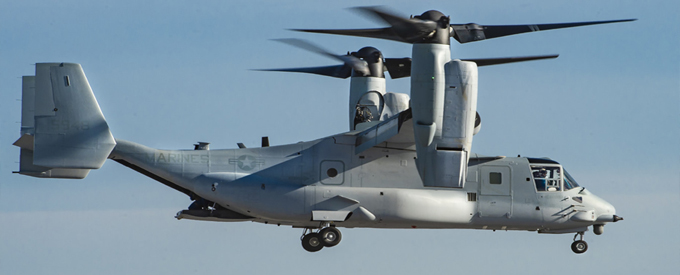2020-01-07
Modified Osprey Reaches U.S. Marine Corps
The first modified MV-22 Osprey was recently delivered to the United States Marine Corps by Boeing and Bell Textron Inc., a Textron Inc. company, for improved readiness and reliability of the tiltrotor fleet.
The Marines have multiple configurations of the MV-22 aircraft in service. Under the Common Configuration – Readiness and Modernization (CC-RAM) programme, Bell Boeing is reportedly reducing the number of configurations by upgrading block “B” aircraft to the current block “C” configuration.
“Our first CC-RAM aircraft returning to Marine Corps Air Station New River was a key programme benchmark,” said U.S. Marine Corps Col. Matthew Kelly, programme manager, V-22 Joint Programme Office (PMA-275). “We are excited to see the capability, commonality and readiness improvements these CC-RAM aircraft bring to the fleet as part of the Marine Corps’ V-22 readiness programme.” The next CC-RAM delivery is expected in early 2020.
As a block “B” configuration, the MV-22 was originally delivered to the fleet in 2005. In 2018, the aircraft flew from Marine Corps Air Station New River to the Boeing Philadelphia facility for modernisation.
“This milestone marks the beginning of an Osprey evolution,” said Kristin Houston, vice president, Boeing Tiltrotor Programmes and director, Bell Boeing V-22 Programme. “Through a shared focus on safety and quality, the Bell Boeing team is delivering modernised MV-22 aircraft that are ready to serve our dedicated servicemen and women who rely on this essential aviation resource.”
“We look forward to having the remaining MV-22 block “B” aircraft re-join the fleet in a block “C” configuration,” said Kelly.
In November 2019, the U.S. Navy awarded Bell Boeing US$146,039,547 to upgrade nine additional MV-22 aircraft under the CC-RAM programme, with work expected to be completed in March 2022.
The Osprey’s wings fold into a 63-foot, 18-foot by 18-foot configuration, which takes up less space on an aircraft carrier. The Osprey can carry 24 combat troops or 20,000 pounds of internal cargo, or 15,000 pounds externally. With a max speed of 275 knots (443 kilometres per hour), it can respond quickly to distant threats. Two customers have used the tilt-rotor technology and flown the aircraft more than 200,000 hours.
Using commercially available logistics optimisation software, V-22 enabled logistics networks demonstrate increased delivery volume and velocity as compared to an optimised legacy COD network by eliminating the logistics “bottleneck” at the carrier. With 100 per cent same-day delivery and efficient asset utilisation, V-22 promises to deliver more to the carrier strike group with mission cost savings up to 50 per cent and up to 44 per cent improved cubic foot throughput.
Optimising readiness of the Osprey fleet around the globe is one of Boeing’s many missions. From performance-based logistics contracting and integrated fleet support to vertical lift maintenance, modifications and repairs, Boeing provides a broad spectrum of products and services, which directly support and enhance capabilities while reducing total cost of ownership.


No Comments